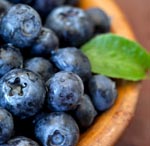Plant blueberries in your garden this year
Put blueberry bushes in your garden this year for fruit and attractive flowers


Now, in the midst of winter, we are planning some new shrub plantings and Vacciniums are high on the list. About 450 species make up the genus, including all the bilberries, huckleberries and cranberries, many of which make very handsome plants, with delicious fruit. Of all the Vaccinium, probably the most beautiful and tasty is V. corymbosum, the highbush blueberry, so we've decided to devote a large chunk of our fruit cage to growing it. Although it's touted as an antioxidant-containing superfood, my main motivation for growing blueberries is the opportunity to harvest fresh, delicious fruit that hasn't flown halfway round the world before it reaches the table.
The bushes have very attractive, pinkish-white flowers in spring and orange to purple autumn colour. Once established, they should give high yields in return for the minimum of care. Good ground preparation is essential for blueberries as they're fussy about soil, needing acidity and plenty of organic matter. On our plot, we dug in lots of fine, composted bark and ericaceous compost and then tested the soil with a pH kit, available from most garden centres. A pH below 5.5 is ideal and, to achieve it, we worked in some sulphur chips, which had the desired result.
The Gravetye soil is naturally quite acidic, so this process was relatively simple, but if you have a very limy soil, raised beds filled with ericaceous compost could be used. Blueberries also do very well in pots, making excellent patio plants, the smaller-growing varieties such as Polaris being best for this treatment. Blueberries are partially self-fertile, but growing a few varieties together helps pollination, enabling bigger crops. The other advantage of growing a number of varieties is that, by planting early, mid-season and late croppers, fresh fruit can be picked from midsummer deep into September.
I've sourced most of my bushes online, from Crocus (0844 557 2233; www.crocus.co.uk), and have selected Spartan for a well-flavoured early crop; Bluecrop for mid season; Chandler for its jumbo, cherry-sized fruit; and Aurora as one of the best late-season blueberries. I'm also very keen to grow Herbert and managed to source it from Ken Muir (01255 830181; www.kenmuir.co.uk). It's said to be one of the best-flavoured blueberries and I want to plant it in honour of Peter Herbert, who founded the hotel at Gravetye in the 1950s.

As well as making fantastic fruit, many Vacciniums are excellent candidates for a woodland garden. Vaccinium vitisidaea, the cowberry or lingonberry, is the sweetest little evergreen shrub, only reaching some 2ft tall. My single plant of it here, which has thrived in deep shade, flowers well in the spring, producing beautiful red berries in the autumn. Cowberries can be used in a similar way to cranberries and are very popular in Scandinavia. This winter, we're going to plant them in blocks through our woodland garden and hope it will make an unusual, beautiful and tasty ground cover.
Vaccinium ovatum, the box blueberry, is a very handsome shrub, which I first came across when I worked in Oregon for a while. It's prolific among the magnificent coniferous forests so associated with that American state, the bushes reaching about 6ft tall and wide. Their deep-green, shiny, evergreen leaves have bronzey-red tones in the spring that flatter its small, urn-shaped white flowers. A delicious purple-black fruit develops, which makes an incredible jam.
I've now discovered V. ovatum at Burncoose nursery (01209 860316; www.burncoose.co.uk), so I plan to make an interesting glade of it, among rhododendrons and Scots pines. My aim is to produce enough fruit to make the wonderful Oregonian jam I remember.
Exquisite houses, the beauty of Nature, and how to get the most from your life, straight to your inbox.
* Follow Country Life on Twitter
Country Life is unlike any other magazine: the only glossy weekly on the newsstand and the only magazine that has been guest-edited by His Majesty The King not once, but twice. It is a celebration of modern rural life and all its diverse joys and pleasures — that was first published in Queen Victoria's Diamond Jubilee year. Our eclectic mixture of witty and informative content — from the most up-to-date property news and commentary and a coveted glimpse inside some of the UK's best houses and gardens, to gardening, the arts and interior design, written by experts in their field — still cannot be found in print or online, anywhere else.
